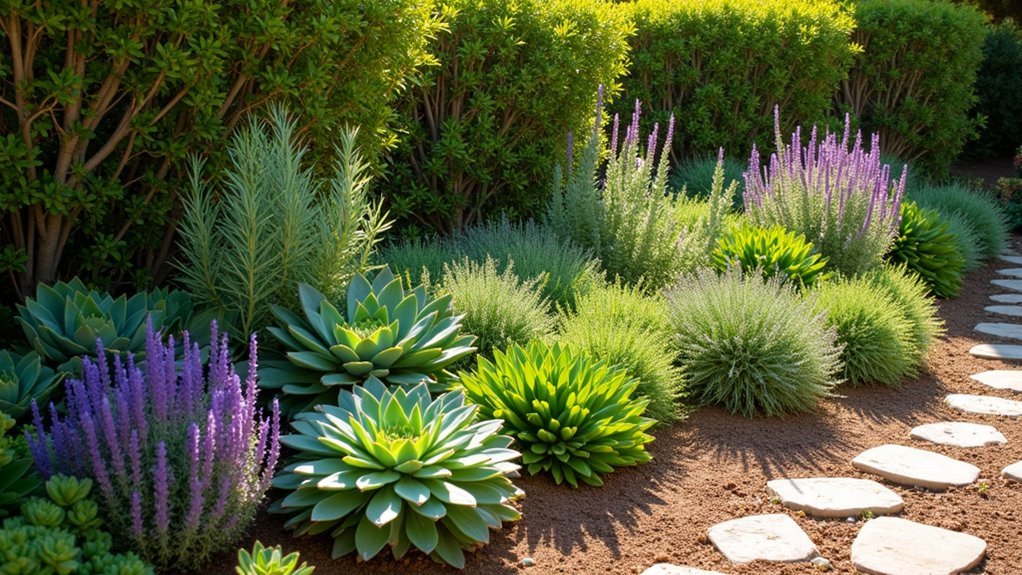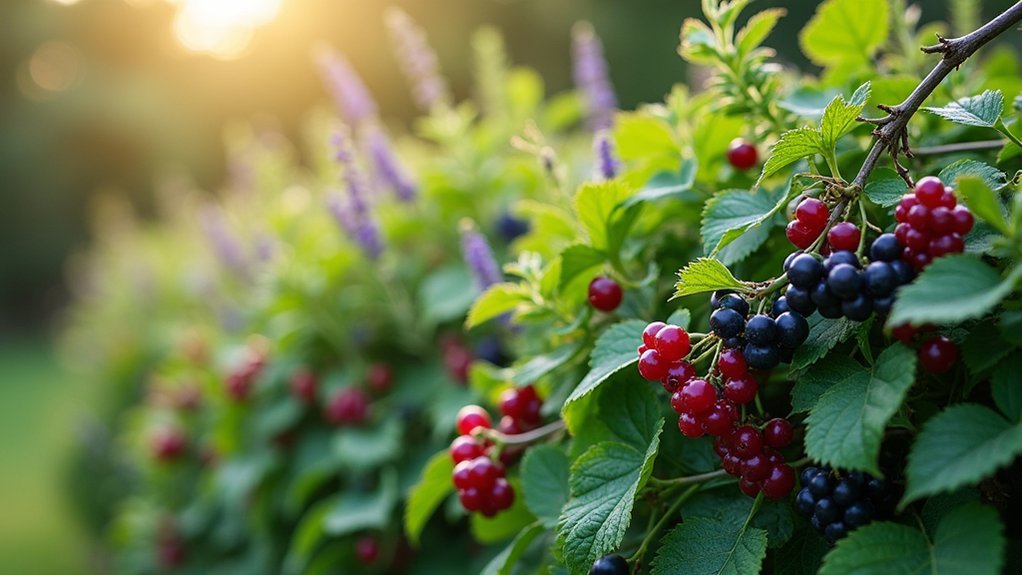Create privacy screens that thrive in dry conditions by planting Mediterranean natives like rosemary, lavender, and sage alongside drought-adapted fruits such as pomegranate, olive, and feijoa. Group plants by water needs, apply 3-4 inches of mulch, and install drip irrigation for efficiency. Space three plants per meter and layer tall, medium, and ground-covering species for dense coverage. Incorporate pest-repelling companions like nasturtiums and parsley to maintain a healthy ecosystem. These strategies will transform your boundary into a productive oasis.
Smart Plant Selection for Low-Water Edible Boundaries

While traditional landscape borders often demand constant irrigation, drought-tough edible boundaries offer a practical alternative that combines beauty with utility.
Transform your garden boundaries into resilient food sources that thrive with minimal water while beautifying your landscape.
When selecting plants, prioritize Mediterranean natives like rosemary, lavender, sage, and thyme—herbs that thrive with minimal water every 10-15 days and provide year-round structure. These aromatics are among the most drought-tolerant herbs available for edible landscapes.
For taller elements, consider drought-adapted trees like feijoa and strawberry guava, which create privacy while producing seasonal harvests.
Pomegranate and olive shrubs offer dense foliage with minimal water requirements once established.
For vertical interest, train grape vines or passionfruit along fences or trellises.
Integrate self-sufficient alliums like walking onions and society garlic as groundcover elements.
These plants not only survive water restrictions but continue providing culinary benefits throughout challenging conditions.
Creating a Climate-Resilient Border: Soil and Position Strategies
Creating a climate-resilient edible border begins with understanding your site’s underlying conditions rather than simply planting and hoping for success. Test your soil composition and amend it with 3-5 inches of compost to improve water retention. Position your plantings strategically—map your property’s topography to capture natural water flow and install swales along contours to harvest rainwater. Implementing conservation agriculture techniques will help maintain soil cover and minimize disturbance, enhancing your border’s resilience to drought conditions.
| Strategy | Benefit | Implementation |
|---|---|---|
| Biochar application | 40% less watering needed | Mix 10-20% into planting holes |
| Windbreak installation | Reduces moisture loss by 30% | Plant tall species on prevailing wind side |
| Hydrozoning | Maximizes water efficiency | Group plants with similar water needs together |
Optimize the root zone with vertical mulching and maintain a thick organic mulch layer to regulate soil temperature and minimize evaporation during heat waves.
Layering Drought-Tolerant Fruiting Plants for Maximum Privacy

Layered planting transforms ordinary garden borders into lush, productive privacy screens that thrive in drought conditions.
Start with a base of dense evergreen shrubs, then add mid-height plants like Southern Living Sunshine Ligustrum for striking color contrast.
For the tallest layer, incorporate drought-hardy fruit producers like ‘Eversweet’ pomegranate or Muskogee Crape Myrtle in a staggered pattern for quicker coverage. These not only provide privacy but also reward you with edible harvests. The Eversweet Pomegranate thrives particularly well with its deep root system and preference for hot summers.
Weave drought-tolerant fruiting vines between layers to fill gaps and add texture.
Remember to space plants properly, allowing each to reach its full potential while maintaining a cohesive screen.
Regular pruning will encourage healthy growth and enhance fruiting potential, giving you a privacy border that’s both beautiful and bountiful year-round.
Water-Wise Maintenance for Productive Privacy Screens
Maintaining drought-tough edible borders requires smart water management to guarantee your privacy screen stays both productive and beautiful.
Establish a 3-inch mulch layer around plants, avoiding direct contact with stems to prevent rot. For established borders, practice infrequent deep watering every 4-6 weeks rather than frequent shallow irrigation.
Install drip systems with automatic timers set for pre-dawn watering when evaporation is minimal. Focus irrigation during critical transplanting and fruiting periods while reducing frequency for mature plants. Microirrigation systems are especially beneficial for delivering water efficiently while reducing foliar disease issues.
Capture rainwater using barrels connected to downspouts or create swales to direct water naturally to your edible border.
Monitor plants daily for stress signals like wilting or leaf curl, and adjust your watering schedule seasonally.
Remember that proper pruning of dead growth reduces water demand while maintaining your screen’s effectiveness.
Multi-Season Harvest Planning for Edible Hedges

You’ll maximize your edible hedge’s productivity by planning a sequence of harvests from early-flowering elderberry to late-season quince and hazelnuts.
To maintain year-round privacy, integrate evergreen herbs like rosemary alongside deciduous fruiting shrubs that provide seasonal coverage.
Stagger your plantings with early, mid, and late varieties of compatible species like blueberries to extend harvest periods by 6-8 weeks while ensuring continuous visual screening.
Plant species at tight spacings of 1-2.5 feet apart to mimic natural thickets and enhance overall productivity and ecosystem health.
Seasonal Harvest Sequence
To maximize the productivity of your drought-tough edible borders, careful planning of the harvest sequence guarantees you’ll enjoy fresh pickings throughout the year.
Begin with early spring strawberries and flowering elderberry, which attracts beneficial insects while providing edible blossoms. The diverse species selection creates a more versatile garden feature that not only offers privacy but enhances the ecological health of your landscape.
As summer arrives, cherries, plums, and blueberries reach their peak, while pollinators buzz around flowering hedgerow plants.
Late summer brings the most abundant harvests—grapes, pears, apples, blackberries, and raspberries all ripen during this period.
In fall, collect sloes, hazelnuts, and quinces before preparing your hedge for winter with strategic pruning and mulching.
Winter’s dormancy offers the perfect opportunity to plant new specimens, train existing plants, and enrich the soil with compost while planning next year’s harvest schedule.
Year-Round Privacy Solutions
Privacy concerns don’t need to compete with your edible landscaping goals when you design a year-round hedge that serves both purposes.
Layer plants strategically for continuous screening—hazelnuts and elderberries reaching 6-10 feet provide backbone structure, while semi-evergreen rugosa roses fill middle gaps.
Incorporate true evergreens like rosemary to maintain winter density when deciduous plants drop leaves. Train brambles horizontally to quickly fill seasonal gaps and establish windbreak protection that benefits neighboring plants.
Multi-season interest comes naturally as spring elderflowers give way to summer blackberry foliage, autumn blueberry color, and winter rose hips. For maximum security, include thorny varieties like blackberry which serve as natural deterrents while producing delicious fruits.
For maximum drought resilience, inoculate roots with mycorrhizal fungi, apply 3-4 inch mulch layers, and group plants by water needs.
This thoughtful design creates privacy that works harder than conventional hedges ever could.
Staggered Ripening Strategy
Beyond securing privacy, your edible border can serve up meals throughout the growing season with careful planning.
Design your hedge with plants that mature at different times to guarantee continuous harvests. Start with wild garlic and early berries for spring picking, then shift to mid-season fruits like currants and gooseberries. By late summer, wild pears will be ready while autumn brings sloes, hazelnuts, and apples.
Even winter can yield harvests if you’ve included medlar or quince. When selecting plants, prioritize drought tolerance and consider pollination needs.
Position compatible varieties near each other to encourage cross-pollination and better yields. For optimal growth and development, use the recommended spacing of three plants per metre when establishing your single-row hedgerow. This strategic approach transforms your privacy hedge from a single-purpose boundary into a productive food system that rewards you with seasonal bounty year-round.
Natural Pest Management in Drought-Resistant Food Borders

You’ll find remarkable success by strategically placing pest-repellent plants like nasturtiums around the perimeter of your drought-resistant food border.
Incorporating members of the Umbelliferae family, such as parsley and dill, will attract beneficial insects that naturally control pest populations without chemical intervention.
These companion planting techniques create a self-regulating ecosystem where predator-attracting plants with small flowers like strawflowers and yarrow maintain the balance between harmful and helpful insects. Consider using white geraniums as they effectively serve as trap crops for Japanese beetles, drawing them away from your valuable edibles like roses and hibiscus.
Companion Planting Benefits
While traditional gardens often struggle with pest management during droughts, companion planting offers a natural solution that enhances the resilience of edible borders. By strategically pairing compatible plants, you’ll create a robust ecosystem that naturally suppresses pests and reduces disease pressure without chemicals.
Your edible border will benefit from improved soil health as legumes fix nitrogen while deep-rooted companions prevent erosion and retain precious moisture. These plant partnerships effectively regulate soil temperature and create favorable microclimates, protecting sensitive crops from extreme weather conditions. Specific plant combinations like nasturtiums that lure caterpillars away from brassicas can be particularly effective in drought-resistant borders.
You’ll also maximize your limited space by growing diverse plants together, increasing overall yields while using water more efficiently. Drought-tolerant combinations share resources intelligently, with taller plants shading more delicate neighbors and living mulches reducing evaporation—creating a self-sustaining border that thrives even when water is scarce.
Predator-Attracting Plants
Natural pest management takes on heightened importance during drought conditions, when stressed plants become more vulnerable to insect attacks.
You’ll want to incorporate specific predator-attracting plants that thrive with minimal water while providing habitat for beneficial insects that control pests naturally.
Flat-leaved parsley varieties like ‘Giant of Italy’ outperform curled types, attracting over 23 beneficial insect species.
Incorporate drought-tolerant natives like goldenrod and yarrow alongside aromatic herbs that serve double duty as both culinary treasures and predator havens. These diverse plant families help create a more resilient garden that can prevent pest outbreaks through balanced insect populations.
- Position umbelliferous flowers (dill, coriander) throughout your border to support ladybugs and parasitic wasps.
- Create undisturbed zones with rock piles and leaf litter for ground beetles.
- Include diverse plant layers—groundcovers, mid-height herbs, and taller flowering plants—to maximize predator hunting zones.
Frequently Asked Questions
How Long Until My Edible Border Provides Effective Privacy?
You’ll wait 2-5 years for full privacy, but fast-growing options like sunflowers offer partial coverage sooner. Combine quick-growing plants with slower perennials for layered privacy while maintaining proper spacing and regular pruning.
Can I Mix Drought-Tolerant and Water-Loving Plants Together?
You can mix drought-tolerant and water-loving plants, but it’s challenging. Create separate zones with appropriate drainage for each plant type, or focus on plants with moderate water needs that tolerate both conditions.
Will Wildlife Damage My Edible Privacy Border?
Wildlife may damage your edible border. You’ll face browsing deer, foraging mammals, and birds. Install 8-foot fencing, use repellents, or choose resistant plants like strong-scented herbs to minimize losses while maintaining biodiversity.
Are All Drought-Resistant Edible Plants Deer-Resistant Too?
No, drought-resistance doesn’t guarantee deer-resistance. While herbs like rosemary and thyme offer both qualities due to strong aromas, many drought-tolerant edibles remain vulnerable to deer browsing, especially during dry periods when food is scarce.
How Do Edible Borders Affect Property Values Compared to Traditional Hedges?
Well-designed edible borders can boost your property value by 5-15%, comparable to traditional hedges’ 5-12.7% increase. You’ll get the added benefit of food production while maintaining similar curb appeal value.
In Summary
You’ve got all the tools to create a beautiful, productive boundary that thrives even in dry conditions. By selecting drought-resistant edibles, preparing your soil properly, and implementing smart watering practices, you’ll enjoy privacy and harvests year after year. Remember, your edible border isn’t just a fence alternative—it’s a sustainable ecosystem that feeds both you and local wildlife while conserving precious water resources.





Leave a Reply